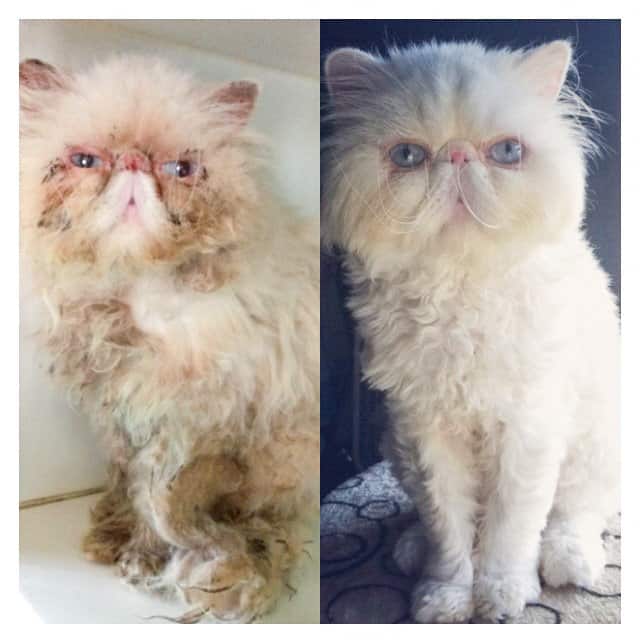"I'll let my Himalayan cat have babies just once or twice. I know I'll find good homes for her kittens."
We hear that on the Pregnant Cats & Kitten Care forum occasionally from irresponsible cat owners. Some backyard breeders think that just because a cat is purebred it is certain to find a forever home. They couldn't be more wrong, as anyone dealing with purebred cat rescue will tell them.
Purebred cats end up in shelters and on the street just like any other cat. Ethical breeders always stipulate in the contract that they are willing to take the cat back. However, they require owners to return the cat rather than surrender it or try to re-home the cat themselves.
Alas, backyard breeders and kitten mills prefer to take the money and move on to producing the next batch of cats for sale.
Specialty Purebred Cat Rescue (SPCR) is a 501c3 nonprofit that tracks down purebred cats in shelters and through owner surrenders.
The cats are placed in foster homes for further rehabilitation until a forever home can be found for them. In a recent email interview, SPCR founder Kirsten Kranz told us about the challenges involved in rescuing purebred cats.
Q: Please tell me more about how SPCR started. Who were the people who started it, and what was the trigger? Who are the people leading the organization today?
A: SPCR was founded by me, and I am the person leading it, as I have been for 15 years. It is a group collaboration in the sense that we have wonderful foster folks who have joined the organization year by year. They do everything from setting up booths at pet expos and cat shows to transporting cats all over, to healing and adopting out thousands of cats. But in terms of decision-making and running this organization, the buck stops here. It is a full-time, 7-day-a-week, non-paid labor of love. Fortunately, my husband has a good job and is very understanding.
SPCR was started gradually when I was volunteering many hours at our local humane society in the 90s. That was the beginning of the rescue group movement. Though there were many groups available for every breed of dog, there was nothing for the purebred cats.
These types of cats only make up a small minority of the cats that flood into shelters every year. However, they tend to have a LOT of issues and are the first to be euthanized. Persians and Himalayans typically come in with everything wrong with them. The average shelter does not have the time, money, or expertise to deal with them. Some breeds like Siamese and Abyssinians are very high-strung and freak out in shelter environments. If there are no resources for them they are put down.
After my time in shelter work, I realized the needs of these unique felines required calm fostering environments. Knowledgeable caregivers were essential for their well-being.
Q: What are the unique challenges of finding homes for purebred cats? Are some breeds more difficult to rehome, possibly due to their special-care needs?
A: Once we developed a niche in social media with our website (www.purebredcatrescue.org), finding homes for our cats has not been a challenge. Our hugely popular Facebook page (6000+ members) has played a significant role in connecting adopters with our cats. I receive over 200 emails a day, and most of those are from folks with inquiries. Our website receives 2000 hits a day. Since it is updated daily there is always that “what’s there” factor that keeps people coming back.

SPBS Volunteer Kay Perry of Oak Park, Illinois, and a foster cat
The challenges revolve more around simply managing a very specialized rescue like this. Additionally, managing the massive vet bills that result from cats often have a lot wrong with them due to severe neglect. The average stray (or owner surrender) Persian has terrible teeth, eye ulcers, and a matted coat. Sometimes, they are unable to breathe due to tiny nostrils. A single cat needs major dental work, a full shave, laser surgery to open the nostrils, medications, blood work, testing, vaccinations, and follow-up care. And that’s not counting a spay or neuter if needed. We place almost 600 cats a year. Our vet bills average $8000+ MONTHLY.
SIGN UP FOR THECATSITE'S EMAIL UPDATES >
Once the cat is healed and ready to go, they do go quickly. People know what they want, and we offer what others don’t. Oddly enough the cats that are the most difficult to rehome are the ones that look most like “regular” cats. We do have a small section on our website devoted to “regular” kitties that come in from time to time. However, they take a LONG time to place. People who visit our site are not looking for “regular” cats. If they were, they would go to their local shelters (which we ALWAYS encourage!)
Q: What are some of the rarer breeds that come through your rescue?
A: We’ve had just about everything. Most recently we’ve been getting in “mixed purebreds”. These include Highlander (curled ears, polydactyl), Lambkins (curly-coated Munchkins), and Bambinos (Munchkin/Sphynx crosses). I think we have only ever had one Singapura in rescue over 15 years, so that is probably the rarest. But that is a very rare breed anyway.
Q: How do you identify a cat as purebred? For example, does every shorthair colorpoint cat qualify as a Siamese or Siamese-derived breed? Do any of the cats come with papers?
A: I would say less than 1 percent of our cats come in with papers. Certainly, every colorpoint shorthair is NOT a purebred Siamese, and we try to make a distinction regarding that. We frequently list “Siamese mixes” and “Maine Coon mixes” because they are in a very gray area that is difficult to determine. However, a Persian is a Persian is a Persian. You can’t miss those flat faces. And when you have been doing this for as long as we have, and attended as many cat shows as our volunteers, you know when you are looking at something real.
Q: Can you please share a memorable story of a cat that found a home through your rescue?
A: Good lord, I don’t even know where to start with that one. There have been so very many. Here is a "before and after” photo of a white Persian male named Max that came in a couple of years ago in horrific condition. He had been living in a cage in a dark basement for years with little to no care. He was surrendered to us under conditions of anonymity because the owners knew they would face charges if their names came out. His transformation under the care of his foster mom Heidi Dooley was simply amazing.

Another side note that people would be interested in is that, as time and space allow, we have taken in dozens of Persians, true Egyptian Maus, and a few Siamese from an animal welfare group in EGYPT over the years (www.esmaegypt.org). We have many pleased adopters who have taken on these cats, and those have been wonderful stories as well. Unfortunately due to the expense and political upheaval in Egypt right now we have not been able to take any this year. But this story alone is very interesting and worth checking out.
Take a minute to visit the Specialty Purebred Cat Rescue website to learn more about the organization and see which cats are currently looking for homes.

Kirsten Kranz with Mouse the Sphynx
Further readings: Saving Feral Cats
SIGN UP FOR THECATSITE'S EMAIL UPDATES >
Note: We may get commissions for purchases made through links on this page.




4 comments on “Rescuing Purebred Cats – Interview With Kirsten Kranz”